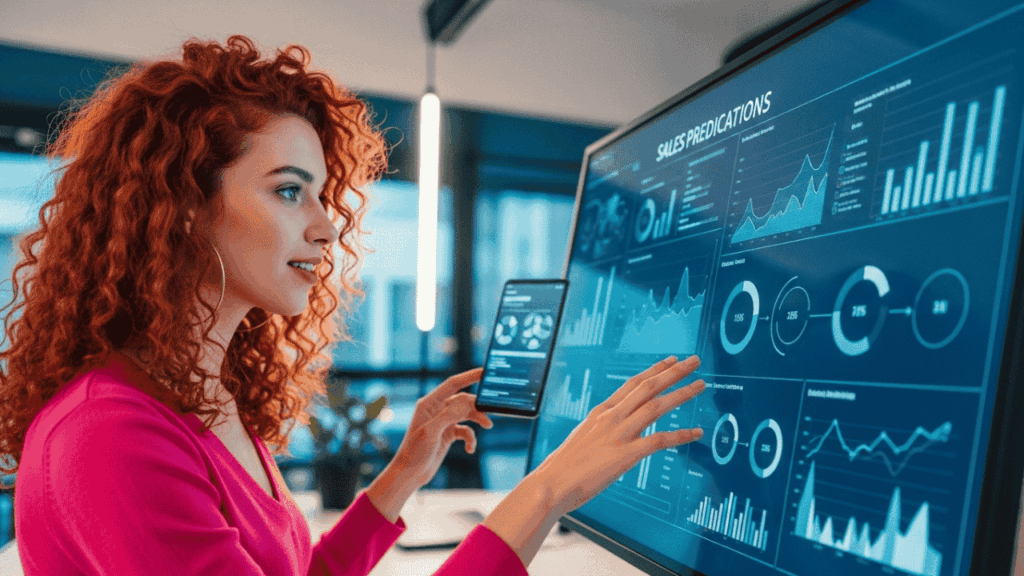You walk into a sales meeting, and instead of scrambling to analyze leads, your AI assistant has already done sales predictions which prospects are most likely to convert, which ones need more nurturing, and which are about to churn.
This isn’t science fiction it’s the power of Predictive AI in sales.
Sales has always been part intuition, part experience. But in 2025, sales success isn’t about guessing it’s about knowing. AI is now more accurate than human forecasting, helping sales teams increase conversion rates by 30% and revenue by 43% (McKinsey, 2024).
But here’s the kicker: Most businesses fail at AI sales predictions.
Why? Because they treat AI as a magic bullet instead of a sales co-pilot.
In this article, we’ll break down:
✅ What Predictive AI in sales is and how it works.
✅ Why most companies fail at implementing AI—and how to avoid their mistakes.
✅ How YOU can use AI to forecast deals, prioritize leads, and close smarter.
Let’s dive in.
What is Predictive AI in Sales? (And Why Should You Care About Sales Predictions?)
Predictive AI in sales is like a fortune teller for revenue—but backed by data, not guesswork.
It uses machine learning, CRM data, and behavioral analytics to forecast:
Which leads are most likely to convert
When deals will close (and how to accelerate them)
Which customers might churn (so you can save them in time)
Quick Fact: 76% of sales teams using AI exceed their revenue targets, compared to just 46% of those who don’t (Salesforce, 2024).
AI is Like Google Maps for Sales Predictions
Think of your sales process as a road trip. Without AI, you’re relying on old maps, gut feelings, and past experiences.
With AI? You get real-time directions, traffic updates, and even alternative routes to get to your goal faster.
AI doesn’t replace salespeople it makes them unstoppable.
How Predictive AI Works in Sales Predictions (Step by Step)
Let’s break it down:
Step 1: AI Collects and Analyzes Sales Data In Sales Predictions
- AI pulls data from your CRM, emails, social media, website visits, and past sales.
- It detects hidden patterns—like which lead behaviors predict a closed deal.
Example: AI might notice that prospects who open three emails and book a demo have a 70% chance of converting.
Step 2: AI Ranks and Scores Your Leads In Sales Predictions
- AI assigns each prospect a lead score based on their engagement, intent, and buying signals.
- Sales reps focus on high-score leads who are most likely to buy.
Tool Spotlight: HubSpot AI automatically scores leads based on website visits, content downloads, and past interactions.
Step 3: AI Predicts When Deals Will Close AI Sales Predictions
- AI forecasts the likelihood of a deal closing in X days or weeks.
- Sales managers can adjust pipelines and forecast revenue more accurately.
Stat: AI-driven forecasting is 85% more accurate than manual sales predictions (Forbes, 2024).
Step 4: AI Suggests the Next Best Action Predictive analytics in sales
- AI tells you whether to call, email, send a LinkedIn message, or offer a discount.
- It analyzes past deals and identifies which strategies work best for each prospect.
Example: AI might find that sending a case study after a discovery call increases conversion rates by 27%.
Step 5: AI Prevents Churn Before It Happens In Sales Predictions
- AI flags customers who show signs of disengagement.
- You can proactively reach out, offer incentives, or adjust messaging.
Case Study: Netflix uses AI to predict when users are about to cancel. By offering a personalized discount, they retain 38% of potential cancellations.

Why Most Companies Fail with Predictive AI (and How to Fix It)
Mistake 1: Thinking AI is a Magic Bullet
Fix: AI is only as good as the sales strategy behind it. It enhances decision-making—it doesn’t replace it.
Mistake 2: Ignoring the Human Element in Sales
Fix: AI predicts leads, but trust still closes deals. Keep personalization and human touch in your outreach.
Mistake 3: Not Training Sales Teams to Use AI Properly
Fix: Invest in training, show reps how AI benefits them, and start with small AI-driven improvements.
How to Implement Predictive AI in Your Sales Strategy

Step 1: Choose the Right AI Sales Tool
Top AI Sales Tools in 2025:
✔ Salesforce Einstein – AI-driven forecasting and lead scoring.
✔ Gong.io – AI insights for sales calls and deal tracking.
✔ HubSpot AI – Automated lead scoring and customer insights.
Step 2: Align AI with Your Sales Process
- AI should integrate with your CRM, sales pipeline, and outreach strategy.
- Start small: Use AI for lead scoring first, then forecasting.
Step 3: Train Your Sales Team
- Salespeople need to trust AI insights—show them how AI improves results.
Step 4: Track Results and Adjust
- Monitor AI predictions vs. actual results and tweak accordingly.
- Set KPIs (lead conversion rates, deal velocity, retention rates).

Conclusion: The Sales Reps Who Use AI Will Win
Sales is changing. The reps who leverage Predictive AI will close more deals, earn more commissions, and dominate their industries.
Start small – use AI for lead scoring or deal forecasting.
Keep the human touch – AI helps, but relationships seal the deal.
Embrace AI or get left behind – your competitors are already using it.
Are you ready to sell smarter in 2025? If so perhaps its best time to know The Best AI CRM Tools for Sales Automation
FAQs
1. What are AI sales predictions?
AI sales predictions use machine learning and data analytics to forecast future sales outcomes—helping businesses make smarter decisions based on patterns, behaviors, and real-time signals.
2. How accurate are AI-powered sales forecasts in 2025?
Top-performing teams report up to 95% forecast accuracy using AI tools. These systems learn from historical data and adapt to market shifts instantly.
3. What kind of data does AI need to make accurate sales predictions?
AI thrives on clean, structured data from CRMs, customer interactions, market trends, and even website behavior. The more integrated your systems, the smarter your forecasts.
4. Can AI help identify high-converting leads?
Yes. AI analyzes buyer intent, engagement signals, and deal history to surface leads most likely to convert—saving time and boosting close rates.
5. Which industries benefit most from AI sales forecasting?
Retail, SaaS, manufacturing, and real estate are leading adopters. But any business with a sales pipeline can gain from smarter forecasting.
6. How does AI adapt to sudden market changes?
Unlike static models, AI updates forecasts in real time—factoring in economic shifts, competitor moves, and buyer behavior changes.
7. What tools are popular for AI sales forecasting in 2025?
Platforms like Salesforce, Clari, BoostUp.ai, and Gong.io offer AI-driven forecasting features, including predictive modeling and conversation intelligence.
8. Is AI replacing human sales reps?
Not at all. AI augments human judgment—handling data-heavy tasks while reps focus on relationships, strategy, and closing deals.
9. How can small businesses use AI for sales predictions?
Many tools offer scalable plans. Even basic CRM integrations can unlock predictive insights without heavy investment.
10. What are the risks of relying on AI for sales forecasting?
Poor data quality, lack of integration, and “black box” models can lead to mistrust or errors. Transparency and training are key to success.

